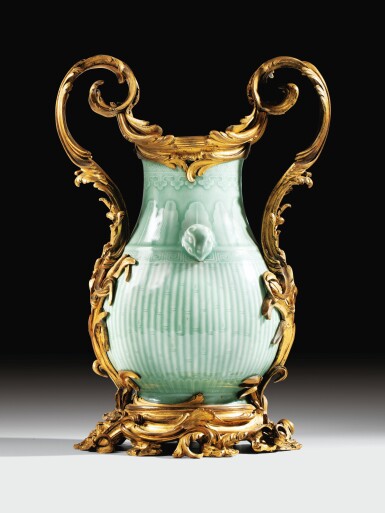
A CELADON-GLAZED VASE, QING DYNASTY, 19TH CENTURY, WITH LOUIS XV STYLE GILT-BRONZE MOUNTS, SECOND HALF 19TH CENTURY | VASE EN PORCELAINE DE CHINE CÉLADON, DYNASTIE QING, XIXE SIÈCLE, À MONTURE DE BRONZE DORÉ DE STYLE LOUIS XV, SECONDE MOITIÉ DU XIXE SIÈCLE
Auction Closed
June 16, 02:34 PM GMT
Estimate
40,000 - 60,000 EUR
Lot Details
Description
A CELADON-GLAZED VASE, QING DYNASTY, 19TH CENTURY, WITH LOUIS XV STYLE GILT-BRONZE MOUNTS, SECOND HALF 19TH CENTURY
the vase with a ribbed body simulating bamboo, below a waisted neck decorated with floral lappets and flanked by stylized animal heads, applied overall with a translucent celadon glaze, the rich gilt-bronze mounted ornament with scrolled acanthus leaf collar issuing two foliate C scrolled handles with intertwined leaves, on a circular foliate scrolled rocaille base
Haut. 49 cm ; height 19¼ in
---------------------------------------------------------------------------
VASE EN PORCELAINE DE CHINE CÉLADON, DYNASTIE QING, XIXE SIÈCLE, À MONTURE DE BRONZE DORÉ DE STYLE LOUIS XV, SECONDE MOITIÉ DU XIXE SIÈCLE
à décor de feuillages, têtes d’animaux stylisés et bambous, recouvert d'une glaçure céladon translucide ; riche ornementation de bronze doré à motifs rocaille, anses en enroulements et joncs entremêlés, sur une base circulaire
Christie's New York, Important French Furniture, Porcelain, Clocks and Carpets, 30th October 1993, lot 290.
---------------------------------------------------------------------------
Vente Christie's, New York, Important French Furniture, Porcelain, Clocks and Carpets, 30 octobre 1993, lot 290
Frick Collection, New York, Mounted Oriental Porcelain, 2 December 1986 - 1 March 1987, no. 33
---------------------------------------------------------------------------
Mounted Oriental Porcelain, exposition à la Frick Collection, New York, du 2 décembre 1986 au 1er mars 1987, n° 33
F.J.B Watson, Mounted Oriental Porcelain, 1986, pp.94-95, no. 33.
F.J.B Watson, 'Mounted Oriental Porcelain', The Magazine Antiques, April 1987, pl. X.
---------------------------------------------------------------------------
F.J.B Watson, Mounted Oriental Porcelain, 1986, pp.94-95, no. 33
F.J.B Watson, 'Mounted Oriental Porcelain', The Magazine Antiques, April 1987, pl. X
The aesthetics of this imposing vase is a continuation of the most beautifully mounted porcelain pieces imagined by merchant-merciers during the second half of the 18th century, as seen in the celebrated Saxe-Teschen collection of watercolour illustrations kept at the Metropolitan Museum in New York.
The design of the Louis XV style gilt-bronze rocaille mounts, continually asymmetrical, yet with symmetry to the details, recalls the most beautiful achievements by bronziers like Duplessis, whose production particularly excelled between 1750 and 1760. It is moreover to this bronzier that we can probably credit authorship of the much admired bronzes on the series of three craquelure celadon porcelain pieces - a pair of ewers and a vase (OA6053) in the Musée du Louvre, and another pair of celadon ewers with an identically designed bronze handle, formerly in the collection of the Comtesse de Béhague and illustrated in an article devoted to her in the March 1988 issue of L’Objet d'Art.
---------------------------------------------------------------------------
L’esthétique de cet imposant vase s’inscrit dans la continuité des plus belles de porcelaines montées imaginées par les marchands-merciers dans la seconde moitié du XVIIIe siècle, comme celles reproduites dans le célèbre album aquarellé dit de Saxe-Teschen conservé au Metropolitan Museum de New York.
Le dessin de la monture de style Louis XV, très rocaille, toujours asymétrique dans les détails, se symétrise et rappelle les plus belles réalisations des bronziers, comme Duplessis qui a particulièrement excellé dans les années 1750-1760. C’est d’ailleurs à ce bronzier que l’on doit probablement la paternité du modèle que l’on peut admirer sur la série de trois porcelaines en céladon craquelé, une paire d’aiguières et un vase (OA6053) appartenant au musée du Louvre. Une autre paire d’aiguières en céladon uni possédant une anse au dessin identique se trouvait dans l’ancienne collection de la comtesse de Béhague, illustrée dans un article qui lui était consacré dans le numéro de mars 1988 de L’Objet d’Art.
